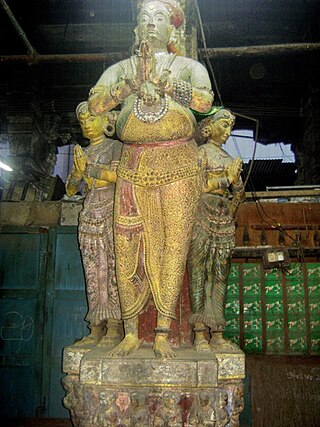Tirumala Nayaka
17th century ruler of Madurai Nayak Dynasty of India From Wikipedia, the free encyclopedia
Tirumala Nayaka (reigned 1623–16 February 1659) was the ruler of Madurai Nayak Dynasty in the 17th century. He ruled Madurai between 1623 and 1659. His contributions are found in the many splendid buildings and temples of Madurai. He belongs to Balija caste.[3] His kingdom was under constant threat from the armies of Bijapur Sultanate and the other neighbouring Muslim kingdoms, which he managed to repulse successfully. His territories comprised much of the old Pandya territories which included Coimbatore, Tirunelveli, Madurai districts, Aragalur in southern Tamil Nadu and some territories of the Travancore kingdom.
| Tirumala Nayaka | |
|---|---|
 A statue of Tirumala Nayaka in Madurai | |
| Nayak of Madurai | |
| Reign | 1623–16 February 1659 |
| Predecessor | Muttu Virappa Nayak |
| Successor | Muttu Veerappa Nayak |
| Born | Madurai, Nayak Kingdom (modern day Tamil Nadu, India) |
| Died | 16 February 1659[1] Madurai, Nayak Kingdom (modern day Tamil Nadu, India) |
| House | Madurai Nayaks |
| Father | Muttu Krishnappa Nayak |
| Religion | Hinduism[2] |
Tirumala Nayaka was a great patron of art and architecture and the Dravidian architecture evolved into the Madurai style. He rebuilt and renovated a number of old temples of the Pandya period. His palace, known as the Tirumala Nayaka Palace, is a notable architectural masterpiece.
| Kings and Queen Regents of Madurai Nayak Dynasty | |
|---|---|
| Part of History of Tamil Nadu | |
 | |
| Madurai Nayak rulers | |
| Viswanatha Nayak | 1529–1563 |
| Kumara Krishnappa Nayak | 1563–1573 |
| Joint Rulers Group I | 1573–1595 |
| Joint Rulers Group II | 1595–1602 |
| Muttu Krishnappa Nayak | 1602–1609 |
| Muttu Virappa Nayak | 1609–1623 |
| Tirumala Nayak | 1623–1659 |
| Muthu Alakadri Nayak | 1659–1662 |
| Chokkanatha Nayak | 1662–1682 |
| Rangakrishna Muthu Virappa Nayak | 1682–1689 |
| Rani Mangammal‡ | 1689–1704 |
| Vijaya Ranga Chokkanatha Nayak | 1704–1731 |
| Queen Meenakshi‡ | 1731–1736 |
| ‡ Regent Queens | |
| Capitals | |
| Madurai | 1529–1616 |
| Tiruchirapalli | 1616–1634 |
| Madurai | 1634–1665 |
| Tiruchirapalli | 1665–1736 |
| Major forts | |
| Madurai 72 Bastion Fort | |
| Tiruchirapalli Rock Fort | |
| Dindigul Fort | |
| Thirunelvelli Fort | |
| other Military forts | |
| Namakkal Fort | |
| Sankagiri Fort | |
| Attur Fort | |
| Palaces | |
| Thirumalai Nayak Mahal, Madurai | |
| Chokkanatha Nayak Palace a.k.a. Durbar Hall, Tiruchirapalli | |
| Rani Mangammal Tamukkam palace Madurai | |
Wars with Mysore
In the early years of Tirumala Nayaka's reign, an invasion of Mysore and counter-invasion of Madura. Recorded in a Mackenzie Manuscript, these conflicts predated Tirumala's later war with the Setupati of Ramnad. While precise dates are elusive, historians like Mr. Rangachari speculate that the Mysore aggression around 1625 may have been instigated by the ambitious Chamaraja Udaiyar, perhaps seeking to assert dominance or rectify past failures. Despite the Mysore general Harasura advance towards Dindigul, but beaten back by Madurai General Ramaiyan of local leaders like Ramaiyyan Ranganna Nayaka the polygar of kannividi the victorious army persuaded the Mysore army and even besieging the Mysore capital. The successful defense earned Ramaiyan great honor from Tirumala Nayaka.[4]
Tirumala Nayaka's Madurai

Tirumala Nayaka's capital was Madurai. The royal residence had been moved from there to Thiruchirapalli by his predecessor, but Tirumala Nayaka moved it back to Madurai again. The reason for this move is claimed to be due to a dream Tirumala Nayaka had but also stated by historians that Madurai has a long history and continuously civilized through ages and Thiruchirapalli is at a threat of immediate attack by Mysore.[5]

Personal life
Ardent devotee
Tirumala Nayaka ate his breakfast only after the pujas were performed at Srivilliputhur Aandal Temple. To get the information that the pujas were completed, the king built mandaps about every five kilometres on the route from Madurai to Srivilliputhur and installed loud bells in them. Each mandap also had a small kitchen. When there was a message to be sent a series of bells rang.[6]
Legacy
In 1974 the Mannar Thirumalai Naicker College was founded in Madurai by Tamilnadu Naidu Mahajana Sangam.[7]
References
External links
Wikiwand - on
Seamless Wikipedia browsing. On steroids.
